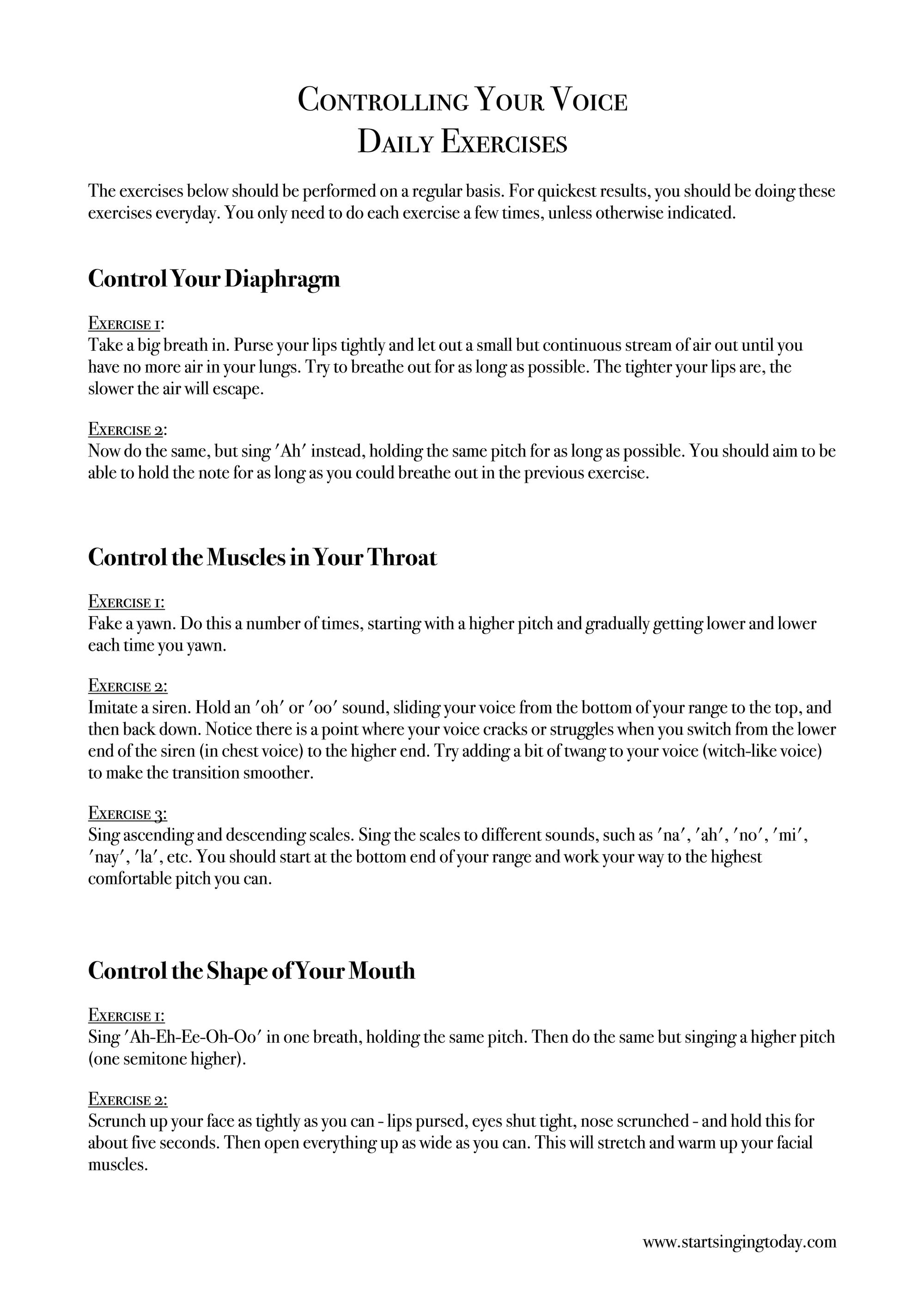Learning to Control Your Singing Voice + Easy Exercises

Every singer must learn to control their voice if they want to get the best out of their performance. A lack of control can lead to unnecessary mistakes or even vocal fatigue. This is a common question for singers, which is why I've put together this little guide to help you take control of your singing voice.
You can learn to control your singing voice by training the muscles used to sing so they are stronger and more controlled. This includes the diaphragm for breathing, throat muscles for pitch/tone, and facial muscles for clarity. It also involves regular practice and quickly correcting any mistakes.
I will explain how these muscles can help improve your singing voice below. I have also included a number of exercises you can do to target those muscles.
Learning to Control Your Voice When Singing
There are some natural hormonal changes in the body that make your voice harder to control, such as menopause, pregnancy and puberty. These changes make it harder to control your voice, but it doesn't mean that you can't regain that control. For some people, they have just never learned to control their voice, limiting the capabilities of their singing.
Below are a number of key elements of singing that you can learn to control. By understanding each of these elements and how you can develop them, you will gain greater control of your voice and ultimately improve your singing.
Controlling Your Diaphragm
Controlling your diaphragm will control your breathing, a key element in voice control. This will allow you to sustain notes for longer, sing longer phrases in the one breath, and sing louder.
Breathing is controlled by a number of muscles in the chest and abdomen, but the diaphragm is the main muscle involved. This is a sheet-like muscle that separates your lungs from your abdominal organs.
When engaged, the diaphragm pushes your abdominal organs down to make room for more air in your lungs. Therefore learning to manipulate the diaphragm will help you gain control over the air in your lungs while you sing.
Fully Engage Your Diaphragm
The first thing you must do as a singer is fully engage your diaphragm when you breath in. This involves taking in as much air as possible with each breath so that your belly expands (make each breath count!). The more your belly expands, the more you are engaging your diaphragm.
Fully engaging your diaphragm means you have taken in as much air as you can, giving you more breath to use when you sing. The next thing you will need to learn is letting that air out slowly.
Slowly Disengaging Your Diaphragm
Releasing the air in your lungs as slowly as possible as you sing will give you a bigger reserve of air as you sing. This will allow you to hold notes longer and sing louder.
To do this, imagine your lungs are a balloon. You can control how much air is released from the balloon using your fingers. Releasing your fingers in one go will let all the air out in a matter of seconds, but keeping your fingers pinched together and opening them slowly will let the air out much more slowly.
You can practice releasing air slowly using the exercises below, therefore teaching your diaphragm to move slowly and smoothly. This will also strengthen it. The more you practice, the less you will need to think about this when you sing.
Exercises
Exercise 1: Take a big breath in (big belly!). Purse your lips tightly and let out a small but continuous stream of air out until you have no more air in your lungs. Try to breathe out for as long as possible. The tighter your lips are, the slower the air will escape.
Exercise 2: Now do the same, but sing 'Ah' instead, holding the same pitch for as long as possible. You should aim to be able to hold the note for as long as you could breathe out in the previous exercise.
Controlling Your Throat Muscles
Controlling your throat muscles will control your pitch and tone, as well as the steadiness of your voice. If you do not have good control over these muscles, you may not be able to sing high or low, may sound too nasally, experience voice cracking, etc.
The main muscles involved are the laryngeal muscles (muscles of the larynx, including the vocal cords), as well as your tongue and soft palate.
Opening up Your Throat
You can open your throat by pushing your the back of your tongue down and pushing your soft palate up. These movements come naturally when we yawn. For this reason, I have included a yawning exercise below.
Opening up the back of your throat in this way can help remove the nasal tone from your voice, something that makes your singing clearer. I have explained this in detail in this article.
Controlling Your Larynx
The larynx is capable of producing amazing sounds. If you can learn to control these muscles, you can manipulate your voice in many different ways. Those that can do impressions have learned this skill and do it well.
The muscles in the larynx need to be exercised regularly in order to build strength and flexibility. This also helps them to work together smoothly. Once you have started exercising these muscles, you will notice that you can sing higher and lower than before (your range will increase), your voice will be steadier, you will develop a nicer tone and
Exercises
Exercise 1: Fake a yawn. Do this a number of times, starting with a higher pitch and gradually getting lower and lower each time you yawn.
Exercise 2: Imitate a siren. Hold an 'oh' or 'oo' sound, sliding your voice from the bottom of your range to the top, and then back down. Try adding a bit of twang to your voice (witch-like voice) to make the transition smoother.
Exercise 3: Sing ascending and descending scales. This is probably the most recognised vocal exercise in the world. Singing the scales to different sounds, such as 'na', 'ah', 'no', 'mi', 'nay', 'la', etc. will exercise most muscles in your larynx
Controlling Your Facial Muscles
Controlling your facial muscles will shape your words, which can control the clarity of your voice. Using your facial muscles to help open up your face can also make your voice sound brighter.
Experimenting with different facial expressions and different vowels in the lyrics can help you sing a particular word with ease. Particularly if the note is uncomfortably high or low.
For example, in Judy Garland's 'Somewhere Over the Rainbow', jumping one octave between 'some' and 'where' can be hard to control. Many new singers struggle to hit the higher note because the jump is too big between notes.
In this example, instead of singing 'Some-Weh', you can try singing 'Some-Wah' (changing the vowel sound). This may sound funny to you, but eventually you should find a good balance between the two sounds (a mix of weh and wah).
This subtle change will make the note easier to reach, and also make the lyrics brighter. The exercises below will help your face become more accustomed to movement when singing, and will also allow you to experiment with these different vowel sounds.
Exercises
Exercise 1: Sing 'Ah-Eh-Ee-Oh-Oo' in one breath, holding the same pitch. Then do the same but singing a higher pitch (one semitone higher).
Exercise 2: Scrunch up your face as tightly as you can - lips pursed, eyes shut tight, nose scrunched - and hold this for about five seconds. Then open everything up as wide as you can. This will stretch and warm up your facial muscles.
Recognising and Correcting Mistakes
Voice control is also about recognising your mistakes and being able to correct them as quickly and smoothly as possible. If your pitch is too high, you should be able to adjust it to where it needs to be. If you are singing too softly, you should be able to increase the volume of your voice.
Training all the muscles mentioned above will help you correct any mistakes you have. Recognising the mistakes is a different skill altogether. But this is also something that you can learn.
Training yourself to recognise mistakes comes with practice, which I will discuss next. You should be trying to copy professional singers to get a feel for whether you are making mistakes or not. It's as simple as how similar your voice sounds to the other singer. However, this is something we all do subconsciously when we sing along to the radio.
Regular Practice
As I mentioned, all of the above can be improved with practice. This is why I have included a list of exercises for you to do to strengthen those singing muscles (you can find the complete list in the image below). Practicing your singing and doing regular exercises will not only teach you to control your voice, but it will make singing easier for you.

